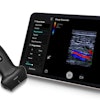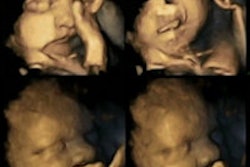ORLANDO, FL - Lung ultrasound can serve as the first-line imaging modality for diagnosing pneumonia in children, avoiding chest x-rays in many cases, according to research presented on Monday at the American Institute of Ultrasound in Medicine (AIUM) annual meeting.
In a randomized controlled trial, researchers from Icahn School of Medicine at Mount Sinai found that performing lung ultrasound first obviated the need for chest x-rays in nearly 40% of patients, according to presenter Dr. Ee Tein Tay.
"It is feasible and safe to substitute lung ultrasound for chest x-ray when evaluating children with suspected pneumonia, with no missed cases of pneumonia or an increase in rates of adverse events," Tay said.
A worthy substitute?
Thanks to its portability, ultrasound is more accessible for patients, and it's also less costly than chest x-ray. Lung ultrasound is also accurate, with a high specificity rate, and it doesn't increase the risk of cancer due to its lack of radiation exposure, Tay said.
"This may be the imaging modality of choice in all healthcare settings for the diagnosis of pneumonia," she said.
The researchers set out to evaluate the feasibility and safety of substituting lung ultrasound for chest x-ray when evaluating children with suspected pneumonia.
"Our hypothesis was that this would ... reduce our use of chest x-ray, without an increase in adverse events including missed illness," she said.
The study included patients (age, 0-21 years) who came to the institution's pediatric emergency room with signs of pneumonia and required imaging for confirmation of diagnosis. Subjects were excluded from the study if they required immediate resuscitation or had a prior chest x-ray for suspected pneumonia.
Via a Web-based computer program, the eligible patients were randomized into one of two groups. In the investigational arm of the study, all subjects received lung ultrasound performed in the institution's emergency department (ED); clinicians also had the option to obtain a chest x-ray if there was clinical uncertainty after the lung ultrasound.
Patients in the control arm of the study underwent a chest x-ray followed by lung ultrasound, which was performed to allow physicians to improve their lung ultrasound skills and to see if any cases of pneumonia or lung infiltrates were missed on chest x-ray, Tay said. For the purposes of the study, the reference gold standard consisted of phone follow-up of patients after one to two weeks and/or review of electronic medical records to determine if there were any adverse outcomes such as missed diagnoses of pneumonia.
The primary outcome measure of the study was a reduction in the chest x-ray utilization rate. The researchers also analyzed the chest x-ray requests that were excluded and stratified them by the experience of the sonologist to see if more-experienced sonologists were able to exclude more chest x-rays.
Secondary outcome measures included unscheduled healthcare visits, rate of antibiotic use, length of stay in the emergency department, and hospital admission rate.
Of the 211 eligible patients who were approached for the study, 20 either did not meet the inclusion criteria or declined to participate. The remaining 191 patients were then split into the investigational arm of the study (103 subjects) or the control group (88 subjects). There were no statistically significant differences in baseline patient characteristics in the two groups.
Fewer chest x-rays
The use of lung ultrasound appeared to reduce the number of chest x-rays, the researchers found. Of the 103 patients in the investigational arm, 63 wound up receiving a chest x-ray after their lung ultrasound.
"We found a 38.8% reduction in chest x-ray utilization in the investigational arm overall," Tay said.
In addition, if the chest x-rays that were performed by request from the admitting physician, primary care doctor, or parent were excluded, there was a potential 67% total reduction in the utilization of chest x-rays, she said.
Sonologist experience also had a considerable effect on the reduction in radiographs. Chest x-ray use dipped by 30% in patients who were scanned by novice sonologists (i.e., those who had performed fewer than 25 lung ultrasounds previously), while utilization dropped by 60.6% for subjects who received their lung ultrasound from experienced sonologists.
There were no cases of missed pneumonia in the study, including the 40 subjects who received only lung ultrasound. There were also no adverse events as a result of patients receiving lung ultrasound or other study procedures.
The researchers also did not find any significant differences between the patient groups for secondary outcome measures such as unscheduled healthcare visits, antibiotic use at index emergency department visit, median length of stay in the ED, and admission rate.
Tay acknowledged a number of limitations of the study, including its single-center design and the fact that clinicians treating the participants were not blinded to the study group assignments. Ethical limitations also prevented the use of a study arm without imaging. In addition, the researchers were unable to calculate test performance characteristics due to the lack of a reference gold standard test.
Nonetheless, the study demonstrated that lung ultrasound could safely and feasibly be used as the initial imaging test for evaluating suspected pediatric pneumonia, the researchers concluded.




















